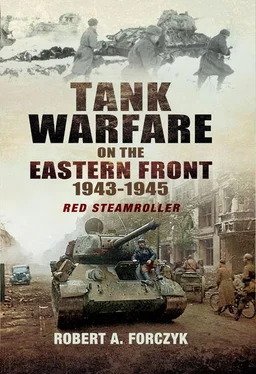• The Hungarian 1st Armoured Division, under Brigadier General Ferenc Horváth, had the 30th Armoured Regiment with two tank battalions consisting of 50–60 operational Pz 38(t) light tanks and up to 20 older Pz IV medium tanks with short 7.5cm howitzers. In addition, Horváth’s division had a company of Toldi light tanks, a company of Csaba armoured cars and a battalion of Nimrod 40mm self-propelled AA guns that could also serve in the anti-tank role. By East Front 1943 standards, the Hungarian 1st Armoured Division was fragile, but it did have the structure of a combined arms team in its attached motorized artillery, infantry, engineers and AA which increased its overall combat value.
• In autumn 1942, Panzer-Verband 700 had been formed from a Panzer-Abteilung staff from 14.Panzer-Division and three Panzer-Kompanien from the 22.Panzer-Division, consisting of a total of 27 rather worn-out Pz 38(t) light tanks. {30}
• Sturmgeschütz-Abteilung 190, commanded by Major Gerhard Peitz, was attached to Gruppe Cramer.
• Sturmgeschütz-Abteilung 242 had just been organized in Germany in November 1942, but one Batterie was sent to Tunisia and the other two went to Heeresgruppe B. The two assault gun batteries were just unloading at Ostrogoshsk on 12 January when Soviet offensive was beginning and the battalion was hurriedly dispatched to support the Hungarian IV Corps.
South of the Hungarian 2nd Army, the remnants of the Italian 8th Army continued to hold a sector along the Don. The three-division Italian Alpine Corps was still relatively intact, plus one other division, but the 8th Army had no organic armour and negligible artillery and anti-tank capabilities. Von Weichs positioned General der Artillerie Martin Wendel’s XXIV Panzerkorps to protect the Italians’ right flank, even though this formation consisted of just the incomplete 27.Panzer-Division (this Panzer-Division had never fully formed and now consisted of just eight operational Pz III/Pz IV medium tanks and a regimental-size mixed arms Kampfgruppe) and a single German infantry division. In addition, the 19.Panzer-Division and Sturmgeschutz-Abteilungen 201 and 209 were deployed in the Italian sector, with 30–40 tanks and 50 or more assault guns. The area between Kantemirovka and Starobelsk was the most dangerous, since the Red Army was across the Don here in force and the seam between the Italian 8th Army and Armee-Abteilung Fretter-Pico was full of gaps.
Under these conditions, Heeresgruppe B needed to have a clear idea of what Golikov’s Voronezh Front intended, but German operational intelligence failed miserably during the winter of 1942–43. In fact, General-leytenant Kirill S. Moskalenko’s 40th Army opposite the 2nd Hungarian Army was reinforced with four tank brigades and the 10th Artillery Division. Moskalenko was a veteran commander who had led the 1st Tank Army in July-August 1942 and now he was provided with plenty of veteran infantry and supporting troops. Even more significant, General-leytenant Pavel S. Rybalko’s 3rd Tank Army was transferred from the RVGK to Golikov’s front, where it moved by rail from Tula to Kantemirovka in early January. Soviet Maskirovka (deception) was so effective that Heeresgruppe B was unaware that a Soviet tank army had moved into this sector until it was too late. Amazingly, Rybalko had held no operational commands in the first two years of the war and had been an instructor at the Kazan Tank School in 1941–42, but he was intelligent and a quick learner. Unlike other Soviet commanders, Rybalko was a very hands-on leader and he taught himself to drive a T-34 tank and spent many hours with his front-line tankers. {31} Rybalko’s army was not fully equipped since it had only the 12th and 15th Tank Corps and 122 of its 493 tanks were non-operational due to mechanical problems. To make up the shortfall, General-major Sergei V. Sokolov’s 7th Cavalry Corps was attached to Rybalko’s army. Soviet logistic preparations for the offensive were rushed, which made it difficult for Rybalko’s tank army to go into battle ready for a protracted operation.
In early January, General Georgy K. Zhukov and General-Polkovnik Aleksandr M. Vasilevsky arrived from the Stavka in Moscow to ‘help’ Golikov develop his plan for the upcoming offensive. [4]The plan was fairly complex, with three different shock groups attacking across a wide front to smash both the Hungarian and Italian armies. {32} Golikov’s north shock group, Moskalenko’s 40th Army, would punch out of the Uryv bridgehead while von Weich’s vulnerable right flank was hit by the southern shock group – Rybalko’s tank army. An independent formation, General-major Petr M. Zykov’s 18th Rifle Group, would form a shock group to cross the Don on the Hungarians’ right flank. On 12 January, Moskalenko conducted a preliminary attack from the Uryv bridgehead with two rifle divisions supported by the 86th Tank Brigade and succeeded in advancing 5km and mauling a regiment from the Hungarian 7th Light Infantry Division. Having gained some elbow room, Moskalenko’s 40th Army conducted a massive artillery preparation the next morning and then hit the Hungarian 7th Division with four rifle divisions and more tanks. In a matter of hours, the Hungarian Division had crumbled under the onslaught and Moskalenko had achieved a breakthrough in the IV Corps sector. The only German reaction was to belatedly move Panzer-Verband 700 to attempt to seal off the Soviet breakthrough, which resulted in a sharp tank action with the Soviet 150th Tank Brigade; the Pz 38(t) light tanks were no match for Soviet T-34s and after losing 14 tanks the German unit retreated northward. Moskalenko began committing his second-echelon forces into the bridgehead, including General-major Andrei G. Kravchenko’s 4th Tank Corps and the 25th Guards Rifle Division. By the end of 14 January, Moskalenko had carved out a larger bridgehead and destabilized the Hungarian centre. Further east, Zykov’s 18th Rifle Corps attacked across the Don after a massive artillery barrage against the Hungarian VII Corps near Shchuchye. In this sector, the Hungarian 12th Light Infantry Division was crushed by nightfall, but Gruppe Cramer committed two German infantry regiments to prevent a breakout.
While Moskalenko was getting across the Don, Rybalko’s 3rd Tank Army also swung into action on the morning of 14 January, after a powerful artillery preparation from the 8th Artillery Division. General-major Vasily A. Koptsov led his 15th Tank Corps northwestward into the fog and struck the XXIV Panzerkorps near Zhilino. Not expecting Soviet armour, the German front in this area was only held by the Führerbegleitabteilung and Waffen-SS Kampfgruppe Fegelein . [5]Koptsov was a very experienced armour officer who had commanded tanks at the battalion, brigade and division level – he knew his job well – and his armour slashed through the German frontline and quickly routed or encircled these small units. The German 387.Infanterie-Division was the only solid unit in this sector, but Rybalkov’s armour blew past its right flank without stopping; once they realized Soviet armour was behind them, the German infantry began retreating. Koptsov’s tankers advanced nearly 20km on the first day and overran the XXIV Panzerkorps command post in Zhilino, where General Wandel was killed in action; 68 of his headquarters staff were captured and later executed in the town square. The 12th Tank Corps and 7th Cavalry Corps covered Koptsov’s flanks while he continued to march north, despite deep snow.
The Ostrogozhsk-Rossosh Operation, 13–31 January 1943.
By 15 January, von Weichs was finally starting to react to the Soviet offensive by ordering Cramer to commit more of his German units and the Hungarian 1st Armoured Division to support the crumbling VII Corps. Hungarian morale cracked quickly once Golikov’s troops were across the Don in force and Soviet tanks began to batter at their thin defences. The Hungarian Armoured Division made some spirited counter-attacks against Zykov’s 18th Rifle Corps’ Shchuchye bridgehead, but suffered heavy losses. Cramer’s 26.Infanterie-Division bought valuable time, but was gutted by the Soviet avalanche coming across the Don and Cramer began a fighting retreat to the town of Ostrogozhsk. By 16 January it was clear that local counter-attacks had failed and that the Hungarian centre and right was on the verge of collapse. Rather than sending the two Sturmgeschütz Abteilung to support the Hungarians, Cramer kept both with his group and they managed to knock out seven Soviet tanks. Cramer’s withdrawal also left the Italian Alpine Corps exposed. In the south, Rybalko’s armour mopped up the remnants of the XXIV Panzerkorps and pushed toward Rossosh to cut off the Italian retreat. The only area that was holding was the German VII Armeekorps (from 2.Armee) at Voronezh, where remnants of the Hungarian III Corps were consolidating; Moskalenko pivoted Kravchenko’s 4th Tank Corps to threaten the 2.Armee’s left flank and to discourage von Weichs from attempting any counterstrokes from this direction.
Читать дальше








![John Stieber - Against the Odds - Survival on the Russian Front 1944-1945 [2nd Edition]](/books/405234/john-stieber-against-the-odds-survival-on-the-russian-front-1944-1945-2nd-edition-thumb.webp)



